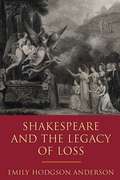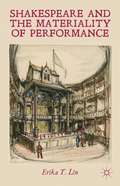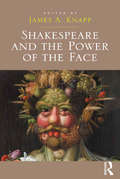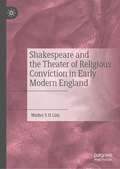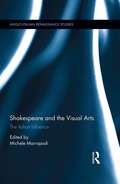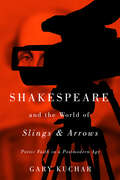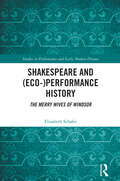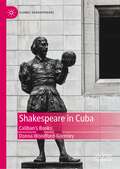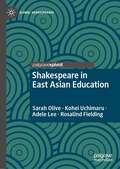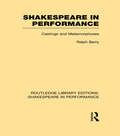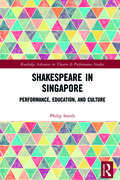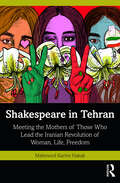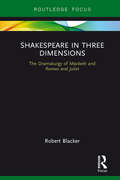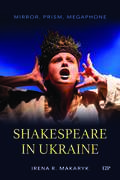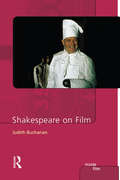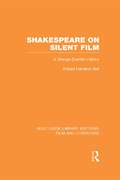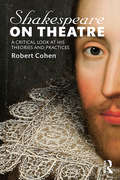- Table View
- List View
Shakespeare and the Legacy of Loss
by Emily Hodgson AndersonHow do we recapture, or hold on to, the live performances we most love, and the talented artists and performers we most revere? Shakespeare and the Legacy of Loss tells the story of how 18th-century actors, novelists, and artists, key among them David Garrick, struggled with these questions through their reenactments of Shakespearean plays. For these artists, the resurgence of Shakespeare, a playwright whose works just decades earlier had nearly been erased, represented their own chance for eternal life. Despite the ephemeral nature of performance, Garrick and company would find a way to make Shakespeare, and through him the actor, rise again. In chapters featuring Othello, Richard III, Hamlet, The Winter’s Tale, and The Merchant of Venice, Emily Hodgson Anderson illuminates how Garrick’s performances of Shakespeare came to offer his contemporaries an alternative and even an antidote to the commemoration associated with the monument, the portrait, and the printed text. The first account to read 18th-century visual and textual references to Shakespeare alongside the performance history of his plays, this innovative study sheds new light on how we experience performance, and why we gravitate toward an art, and artists, we know will disappear.
Shakespeare and the Materiality of Performance
by Erika T. LinWinner of the MRDS 2013 David Bevington Award for Best New Book in Early Drama Studies! Drawing on a wide variety of primary sources, Lin reconstructs playgoers' typical ways of thinking and feeling and demonstrates how these culturally-trained habits of mind shaped dramatic narratives and the presentational dynamics of onstage action.
Shakespeare and the Power of the Face
by James A. KnappThroughout his plays, Shakespeare placed an extraordinary emphasis on the power of the face to reveal or conceal moral character and emotion, repeatedly inviting the audience to attend carefully to facial features and expressions. The essays collected here disclose that an attention to the power of the face in Shakespeare’s England helps explain moments when Shakespeare’s language of the self becomes intertwined with his language of the face. As the range of these essays demonstrates, an attention to Shakespeare’s treatment of faces has implications for our understanding of the historical and cultural context in which he wrote, as well as the significance of the face for the ongoing interpretation and production of the plays. Engaging with a variety of critical strands that have emerged from the so-called turn to the body, the contributors to this volume argue that Shakespeare’s invitation to look to the face for clues to inner character is not an invitation to seek a static text beneath an external image, but rather to experience the power of the face to initiate reflection, judgment, and action. The evidence of the plays suggests that Shakespeare understood that this experience was extremely complex and mysterious. By turning attention to the face, the collection offers important new analyses of a key feature of Shakespeare’s dramatic attention to the part of the body that garnered the most commentary in early modern England. By bringing together critics interested in material culture studies with those focused on philosophies of self and other and historians and theorists of performance, Shakespeare and the Power of the Face constitutes a significant contribution to our growing understanding of attitudes towards embodiment in Shakespeare’s England.
Shakespeare and the Second World War
by Irena Makaryk Marissa MchughShakespeare's works occupy a prismatic and complex position in world culture: they straddle both the high and the low, the national and the foreign, literature and theatre. The Second World War presents a fascinating case study of this phenomenon: most, if not all, of its combatants have laid claim to Shakespeare and have called upon his work to convey their society's self-image.In wartime, such claims frequently brought to the fore a crisis of cultural identity and of competing ownership of this 'universal' author. Despite this, the role of Shakespeare during the Second World War has not yet been examined or documented in any depth. Shakespeare and the Second World War provides the first sustained international, collaborative incursion into this terrain. The essays demonstrate how the wide variety of ways in which Shakespeare has been recycled, reviewed, and reinterpreted from 1939-1945 are both illuminated by and continue to illuminate the War today.
Shakespeare and the Theater of Religious Conviction in Early Modern England
by Walter S LimThis book analyzes Shakespeare’s use of biblical allusions and evocation of doctrinal topics in Hamlet, Measure for Measure, The Winter’s Tale, Richard II, and The Merchant of Venice. It identifies references to theological and doctrinal commonplaces such as sin, grace, confession, damnation, and the Fall in these plays, affirming that Shakespeare’s literary imagination is very much influenced by his familiarity with the Bible and also with matters of church doctrine. This theological and doctrinal subject matter also derives its significance from genres as diverse as travel narratives, sermons, political treatises, and royal proclamations. This study looks at how Shakespeare’s deployment of religious topics interacts with ideas circulating via other cultural texts and genres in society. It also analyzes how religion enables Shakespeare’s engagement with cultural debates and political developments in England: absolutism and law; radical political theory; morality and law; and conceptions of nationhood.
Shakespeare and the Visual Arts: The Italian Influence (Anglo-Italian Renaissance Studies)
by Michele MarrapodiCritical investigation into the rubric of 'Shakespeare and the visual arts' has generally focused on the influence exerted by the works of Shakespeare on a number of artists, painters, and sculptors in the course of the centuries. Drawing on the poetics of intertextuality and profiting from the more recent concepts of cultural mobility and permeability between cultures in the early modern period, this volume’s tripartite structure considers instead the relationship between Renaissance material arts, theatre, and emblems as an integrated and intermedial genre, explores the use and function of Italian visual culture in Shakespeare’s oeuvre, and questions the appropriation of the arts in the production of the drama of Shakespeare and his contemporaries. By studying the intermediality between theatre and the visual arts, the volume extols drama as a hybrid genre, combining the figurative power of imagery with the plasticity of the acting process, and explains the tri-dimensional quality of the dramatic discourse in the verbal-visual interaction, the stagecraft of the performance, and the natural legacy of the iconographical topoi of painting’s cognitive structures. This methodolical approach opens up a new perspective in the intermedial construction of Shakespearean and early modern drama, extending the concept of theatrical intertextuality to the field of pictorial arts and their social-cultural resonance. An afterword written by an expert in the field, a rich bibliography of primary and secondary literature, and a detailed Index round off the volume.
Shakespeare and the Visual Imagination
by Stuart SillarsShakespeare's knowledge of the practices of visual art, its fundamental concepts and the surrounding debates is clear from his earliest works. This book explores this relationship, showing how key works develop visual compositions as elements of dramatic movement, construction of ideas, and reflections on the artifice of theatre and language. The Taming of the Shrew, Love's Labour's Lost, Richard II and A Midsummer Night's Dream are explored in detail, offering new insights into their forms, themes, and place in European traditions. The use of emblems is examined in Titus Andronicus and As You Like It; studies of Venus and Adonis, some sonnets and The Rape of Lucrece reveal different but related visual aspects; a later chapter suggests how the new relation between seeing and soliloquy in The Rape of Lucrece is developed in other plays. Extensively illustrated, the book explores Shakespeare's assimilation and exploration of visual traditions in structure, theme and idea throughout the canon.
Shakespeare and the World of “Slings & Arrows”: Poetic Faith in a Postmodern Age
by Gary KucharSlings & Arrows, starring Susan Coyne, Paul Gross, Don McKellar, and Mark McKinney as members of the New Burbage Theatre Festival, was heralded by television critics as one of the best shows ever produced and one of the finest depictions of life in classical theatre. Shakespeare scholars, however, have been ambivalent about the series, at times even hostile.In Shakespeare and the World of “Slings & Arrows” Gary Kuchar situates the three-season series in its cultural and intellectual contexts. More than a roman à clef about Canada’s Stratford Festival, he shows, it is a privileged window onto major debates within Shakespeare studies and a drama that raises vital questions about the role of the arts in society. Kuchar reads the television show – ever fluctuating between faith and doubt in the power of drama – as an allegory of Peter Brook’s widely renowned account of modern theatre, The Empty Space, mirroring Brook’s distinction between holy theatre, a quasi-sacred vocation, and deadly theatre, a momentary entertainment.Combining contextualized interpretations of the series with subtle formalist readings, Kuchar explains how Slings & Arrows participates in a broader recuperation of humanist approaches to Shakespeare in contemporary scholarship. The result is a demonstration of how and why Shakespeare continues to provide not just entertainment, but equipment for living.
Shakespeare and: The Merry Wives of Windsor (ISSN)
by Elizabeth SchaferSeismic shifts in the theatrical meanings of The Merry Wives of Windsor have taken place across the centuries as Shakespeare’s frequently performed play has relocated to Windsor across the world, journeying along the production/adaptation/appropriation continuum.This (eco-)performance history of Shakespeare’s The Merry Wives of Windsor not only offers the first in-depth analysis of the play in production, with a particular focus on the representation of merry women, but also utilises the comedy’s forest-aware dramaturgy to explore Mistress Page’s concept of being ‘frugal in my mirth’ in relation to sustainable theatre practices. Herne’s Oak – the fictitious tree in Windsor Forest where everyone meets in the final scene of the play – is utilised to enable a maverick but ecologically based reframing of the productions of Merry Wives analysed here.This study engages with gender, physical comedy, and cultural relocations of Windsor across the world to offer new insight into Merry Wives and its theatricality.
Shakespeare behind Bars: One Teacher's Story of the Power of Drama in a Women's Prison
by Jean TrounstineIn this deeply stirring account, Jean Trounstine, who spent 10 years teaching at Framingham (MA) Women's Prison, focuses on six inmates who, each in her own way, discover in the power of Shakespeare a way to transcend the painful constraints of incarceration. Shakespeare Behind Bars is a powerful story about the redemptive power of art and education. Originally published in cloth in 2001, the paperback includes a new foreword that will inspire all teachers who work with students others have deemed unteachable. A new afterword updates readers on the prison art's program -- and the author herself -- since 2001.
Shakespeare in Cuba: Caliban’s Books (Global Shakespeares)
by Donna Woodford-GormleyShakespeare in Cuba: Caliban’s Books explores how Shakespeare is consumed and appropriated in Cuba. It contributes to the underrepresented field of Latin American Shakespeares by applying the lens of cultural anthropophagy, a theory with Latin American roots, to explore how Cuban artists ingest and transform Shakespeare’s plays. By consuming these works and incorporating them into Cuban culture and literature, Cuban writers make the plays their own while also nourishing the source texts and giving Shakespeare a new afterlife.
Shakespeare in East Asian Education (Global Shakespeares)
by Adele Lee Rosalind Fielding Sarah Olive Kohei UchimaruThis book offers fresh, critical insights into Shakespeare in Hong Kong, Japan, and Taiwan. It recognises that Shakespeare in East Asian education is not confined to the classroom or lecture hall but occurs on diverse stages. It covers multiple aspects of education: policy, pedagogy, practice, and performance. Beyond researchers in these areas, this book is for those teaching and learning Shakespeare in the region, those teaching and learning English as an Additional Language anywhere in the world, and those making educational policies, resources, or theatre productions with young people in East Asia.
Shakespeare in Malawi: Power and Performance (Global Shakespeares)
by Amy BonsallThis book critically examines the forces and events that led to Shakespeare performance becoming an important part of the contemporary Malawian cultural and educational landscape. It brings together archive material, interviews, existing literature and practice as research to understand, examine and interrogate theories of ‘intercultural theatre’ and post-colonial theories, to highlight the unique practice of Shakespeare production in Malawi. A timeline of Shakespeare productions in Malawi is included, spanning the colonialist period through to the present day. The book explores local adaptations of As You Like It and Macbeth and the translation into Chichewa of Romeo and Juliet, providing a unique insight into the practice and methodologies of Malawian Shakespeare translation, including the role of women as performers and artists. It looks at the current state of drama and theatre in Malawi and what the future of Shakespeare in Malawi might look like.
Shakespeare in Performance: Castings and Metamorphoses (Routledge Library Editions: Shakespeare in Performance)
by Ralph BerryThese studies take stage history as a means of knowing the play. Half of the studies deal with casting - doubling, chorus and the crowd, the star of Hamlet and Measure for Measure. Then the transformations of dramatis personae are analyzed and The Tempest is viewed through the changing relationships of Prospero, Ariel and Caliban. Some of Shakespeare’s most original strategies for audience control are studied, such as Cordelia's asides in King Lear, Richard II’s subversive laughter and the scenic alternation of pleasure and duty in Henry IV. Performance is the realization of identity. The book draws on major productions up to 1992, just before the book was originally published.
Shakespeare in Quebec
by Jennifer DrouinIn Shakespeare in Québec, Jennifer Drouin analyses representations of nation and gender in Shakespearean adaptations written in Québec since the Quiet Revolution. Using postcolonial and gender theory, Drouin traces the evolution of discourses of nation and gender in Québec from the Conquest of New France to the present, and she elaborates a theory of adaptation specific to Shakespeare studies.Drouin's book explains why Québécois playwrights seem so obsessed with rewriting "le grand Will," what changes they make to the Shakespearean text, and how the differences between Shakespeare and the adaptations engage the nationalist, feminist, and queer concerns of Québec society.Close readings from ten plays investigate the radical changes to content that allowed Québécois playwrights to advocate for political change and contribute to the hot debates of the Quiet Revolution, the 1970 October Crisis, the 1980 and 1995 referenda, the rise of feminism, and the emergence of AIDS. Drouin reveals not only how Shakespeare has been adapted in Québec but also how Québécois adaptations have evolved in response to changes in the political climate. As a critical analysis in English of rich but largely ignored French plays, Shakespeare in Québec bridges Canada's "two solitudes."
Shakespeare in Singapore: Performance, Education, and Culture (Routledge Advances in Theatre & Performance Studies)
by Philip SmithShakespeare in Singapore provides the first detailed and sustained study of the role of Shakespeare in Singaporean theatre, education, and culture. This book tracks the role and development of Shakespeare in education from the founding of modern Singapore to the present day, drawing on sources such as government and school records, the entire span of Singapore's newspaper archives, playbills, interviews with educators and theatre professionals, and existing academic sources. By uniting the critical interest in Singaporean theatre with the substantial body of scholarship that concerns global Shakespeare, the author overs a broad, yet in-depth, exploration of the ways in which Singaporean approaches to Shakespeare have been shaped by, and respond to, cultural work going on elsewhere in Asia. A vital read for all students and scholars of Shakespeare, Shakespeare in Singapore offers a unique examination of the cultural impact of Shakespeare, beyond its usual footing in the Western world.
Shakespeare in Singapore: Performance, Education, and Culture (Routledge Advances in Theatre & Performance Studies)
by Philip SmithShakespeare in Singapore provides the first detailed and sustained study of the role of Shakespeare in Singaporean theatre, education, and culture. This book tracks the role and development of Shakespeare in education from the founding of modern Singapore to the present day, drawing on sources such as government and school records, the entire span of Singapore's newspaper archives, playbills, interviews with educators and theatre professionals, and existing academic sources. By uniting the critical interest in Singaporean theatre with the substantial body of scholarship that concerns global Shakespeare, the author overs a broad, yet in-depth, exploration of the ways in which Singaporean approaches to Shakespeare have been shaped by, and respond to, cultural work going on elsewhere in Asia. A vital read for all students and scholars of Shakespeare, Shakespeare in Singapore offers a unique examination of the cultural impact of Shakespeare, beyond its usual footing in the Western world.
Shakespeare in Tehran: Meeting the Mothers of Those Who Lead the Iranian Revolution of Woman, Life, Freedom
by Mahmood Karimi HakakShakespeare in Tehran is a personal history of Iran through the eyes of an award-winning Iranian American artist. Drawing on parallels between life and the stage, it uses A Midsummer Night’s Dream as a roadmap to explore social, political, economic, and cultural aspects of Iran before and after the revolution of 1979. Through first-person accounts, interspersed with emotional reflections of the universal human experience, it delves into the historical and sociological context of a divided country. Storytelling, flashbacks, and flashforwards paint an intimate picture of public life in Iran in a time of uncertainty. Accessible, engaging, and nuanced, this volume will be of interest to scholars and researchers of politics, history, theater and performance studies, and West Asian studies.
Shakespeare in Three Dimensions: The Dramaturgy of Macbeth and Romeo and Juliet (Focus on Dramaturgy)
by Robert BlackerIn Shakespeare in Three Dimensions, Robert Blacker asks us to set aside what we think we know about Shakespeare and rediscover his plays on the page, and as Shakespeare intended, in the rehearsal room and in performance. That process includes stripping away false traditions that have obscured his observations about people and social institutions that are still vital to our lives today. This book explores the verities of power and love in Romeo and Juliet and Macbeth, as an example of how to mine the extraordinary detail in all of Shakespeare’s plays, using the knowledge of both theatre practitioners and scholars to excavate and restore them.
Shakespeare in Ukraine: Mirror, Prism, Megaphone
by Irena R. MakarykOften regarded as a playwright “beyond nationality,” Shakespeare has played a central role in Ukraine's cultural history over the past two centuries. His works have served as both a lens for exploring Ukraine’s historical and cultural identity and as a shared medium through which Ukrainian poets, dramatists, and theatre artists have communicated with the world. Shakespeare in Ukraine: Mirror, Prism, Megaphone, by award-winning Shakespearean and theatre historian Irena R. Makaryk, analyzes key moments of Ukraine’s engagement with Shakespeare. The text traces the evolution of Shakespeare in Ukraine, from his early influence on figures like Taras Shevchenko and Lesya Ukrainka to the groundbreaking theatrical work of Les Kurbas, the first to stage Shakespeare in 1920, a bold assertion of cultural identity and independence. The volume also explores the defiant production of Hamlet under Nazi occupation in 1943, adaptations of Shakespeare’s works under Soviet rule, Shakespeare commemorations in the Cold War era, and the efflorescence of Shakespeare productions in the post-independence period. Rich with astute scholarly observations and fascinating historical details, Shakespeare in Ukraine investigates the multifaceted roles of Shakespeare during periods of great cultural and political upheaval. From the early Soviet period to the ongoing war with Russia, Makaryk offers insights into the enduring power of Shakespeare and the way he amplifies Ukraine’s creative and cultural imagination.
Shakespeare on Film
by Judith R. BuchananFrom the earliest days of the cinema to the present, Shakespeare has offered a tempting bank of source material than the film industry has been happy to plunder. Shakespeare on Film deftly examines an extensive range of films that have emerged from the curious union of an iconic dramatist with a medium of mass appeal. The many films Buchanan studies are shown to be telling indicators of trends in Shakespearean performance interpretation, illuminating markers of developments in the film industry and culturally revealing about broader influences in the world beyond the movie theatre. As with other titles from the Inside Film series, the book is illustrated throughout with stills. Each chapter concludes with a list of suggested further reading in the field.
Shakespeare on Screen Othello
by Hatchuel, Sarah and Vienne-Guerrin, Nathalie Sarah Hatchuel Nathalie Vienne-Guerrin"The first volume in the re-launched series Shakespeare on Screen is devoted to Othello, offering up-to-date coverage of recent screen versions as well as new critical essays on older, canonical films. An international cast of authors explores not only productions from the USA and UK, but also translations, adaptations and appropriations in Québec, Italy, India, Brazil and Mexico. The volume takes part in the ceaseless cultural investigation of what Othello says about Shakespeare, the past and our present time, supported by an invaluable film-bibliography. Accompanying free online resources include a fuller version of the bibliography and an additional contribution on YouTube versions of Othello. This book will be a valuable resource for students, scholars and teachers of film studies and Shakespeare studies"--
Shakespeare on Silent Film: A Strange Eventful History (Routledge Library Editions: Film and Literature)
by Robert Hamilton BallIn 1899, when film projection was barely three years old, Herbert Beerbohm Tree was filmed as King John. In his highly entertaining history, Robert Hamilton Ball traces in detail the fate of Shakespeare on silent films from Tree’s first effort until the establishment of sound in 1929. The silent films brought Shakespeare to a wide public who had never had the chance to see his plays in the theatre. And Shakespeare gave the film makers an air of respectability that was badly needed by a medium with a reputation for frivolity. This work, first published in 1968, brings history to life with excerpts from scenarios, from reviews and from contemporary film journals, and with reproduction of stills and frames from the films themselves, including unusual shots of leading screen actors. This is a valuable source book for film experts, enhanced by full notes, bibliography and indexes; a fresh approach for Shakespeareans; and a vivid sketch of a world that has passed for all.
Shakespeare on Theatre: A Critical Look at His Theories and Practices
by Robert CohenIn Shakespeare on Theatre, master acting teacher Robert Cohen brilliantly scrutinises Shakespeare's implicit theories of acting, paying close attention to the plays themselves and providing a wealth of fascinating historical evidence. What he finds will surprise scholars and actors alike – that Shakespeare's drama and his practice as an actor were founded on realism, though one clearly distinct from the realism later found in Stanislavski. Shakespeare on Acting is an extraordinary introduction to the way the plays articulate a profound understanding of performance and reflect the life and times of a uniquely talented theatre-maker.
Shakespeare on the University Stage
by Andrew James HartleyFeaturing essays from seventeen international scholars, this exciting new collection is the first sustained study of Shakespeare on the university and college stage. Treating the subject both historically and globally, the essays describe theatrical conditions that fit neither the professional nor the amateur models and show how student performances provide valuable vehicles for artistic construction and intellectual analysis. The book redresses the neglect of this distinctive form of Shakespeare performance, opening up new ways of thinking about the nature and value of university production and its ability to draw unique audiences. Looking at productions across the world - from Asia to Europe and North America - it will interest scholars as well as upper-level students in areas such as Shakespeare studies, performance studies and theatre history.
